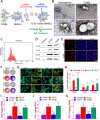Chondrogenic primed extracellular vesicles activate miR-455/SOX11/FOXO axis for cartilage regeneration and osteoarthritis treatment
- PMID: 36114225
- PMCID: PMC9481593
- DOI: 10.1038/s41536-022-00250-7
Chondrogenic primed extracellular vesicles activate miR-455/SOX11/FOXO axis for cartilage regeneration and osteoarthritis treatment
Abstract
Osteoarthritis (OA) is the leading cause of disability worldwide. Considerable progress has been made using stem-cell-derived therapy. Increasing evidence has demonstrated that the therapeutic effects of BMSCs in chondrogenesis could be attributed to the secreted small extracellular vesicles (sEVs). Herein, we investigated the feasibility of applying engineered EVs with chondrogenic priming as a biomimetic tool in chondrogenesis. We demonstrated that EVs derived from TGFβ3-preconditioned BMSCs presented enriched specific miRNAs that could be transferred to native BMSCs to promote chondrogenesis. In addition, We found that EVs derived from TGFβ3-preconditioned BMSCs rich in miR-455 promoted OA alleviation and cartilage regeneration by activating the SOX11/FOXO signaling pathway. Moreover, the designed T3-EV hydrogel showed great potential in cartilage defect treatment. Our findings provide new means to apply biosafe engineered EVs from chondrogenic primed-BMSCs for cartilage repair and OA treatment, expanding the understanding of chondrogenesis and OA development modulated by EV-miRNAs in vivo.
© 2022. The Author(s).
Conflict of interest statement
The authors declare no competing interests.
Figures







Similar articles
-
Intra-articular delivery of extracellular vesicles secreted by chondrogenic progenitor cells from MRL/MpJ superhealer mice enhances articular cartilage repair in a mouse injury model.Stem Cell Res Ther. 2020 Mar 2;11(1):93. doi: 10.1186/s13287-020-01594-x. Stem Cell Res Ther. 2020. PMID: 32122385 Free PMC article.
-
EVs from cells at the early stages of chondrogenesis delivered by injectable SIS dECM promote cartilage regeneration.J Tissue Eng. 2024 Aug 17;15:20417314241268189. doi: 10.1177/20417314241268189. eCollection 2024 Jan-Dec. J Tissue Eng. 2024. PMID: 39157647 Free PMC article.
-
Ultrasound-Driven Healing: Unleashing the Potential of Chondrocyte-Derived Extracellular Vesicles for Chondrogenesis in Adipose-Derived Stem Cells.Biomedicines. 2023 Oct 19;11(10):2836. doi: 10.3390/biomedicines11102836. Biomedicines. 2023. PMID: 37893208 Free PMC article.
-
Extracellular Vesicles in chondrogenesis and Cartilage regeneration.J Cell Mol Med. 2021 Jun;25(11):4883-4892. doi: 10.1111/jcmm.16290. Epub 2021 May 4. J Cell Mol Med. 2021. PMID: 33942981 Free PMC article. Review.
-
The Therapeutic Potential of Bone Marrow Mesenchymal Stem Cells for Articular Cartilage Regeneration in Osteoarthritis.Curr Stem Cell Res Ther. 2021;16(7):840-847. doi: 10.2174/1574888X16666210127130044. Curr Stem Cell Res Ther. 2021. PMID: 33504316 Review.
Cited by
-
Harnessing Stem Cell-Derived Extracellular Vesicles for the Regeneration of Degenerative Bone Conditions.Int J Nanomedicine. 2023 Sep 29;18:5561-5578. doi: 10.2147/IJN.S424731. eCollection 2023. Int J Nanomedicine. 2023. PMID: 37795043 Free PMC article. Review.
-
A novel mesenchymal stem cell-targeting dual-miRNA delivery system based on aptamer-functionalized tetrahedral framework nucleic acids: Application to endogenous regeneration of articular cartilage.Bioact Mater. 2024 Aug 19;40:634-648. doi: 10.1016/j.bioactmat.2024.08.008. eCollection 2024 Oct. Bioact Mater. 2024. PMID: 39253616 Free PMC article.
-
Articular cartilage repair biomaterials: strategies and applications.Mater Today Bio. 2024 Jan 6;24:100948. doi: 10.1016/j.mtbio.2024.100948. eCollection 2024 Feb. Mater Today Bio. 2024. PMID: 38269053 Free PMC article. Review.
-
Therapeutics of the future: Navigating the pitfalls of extracellular vesicles research from an osteoarthritis perspective.J Extracell Vesicles. 2024 Jul;13(7):e12435. doi: 10.1002/jev2.12435. J Extracell Vesicles. 2024. PMID: 38943211 Free PMC article. Review.
-
Prevalence and plasma exosome-derive microRNA diagnostic biomarker screening of adolescent idiopathic scoliosis in Yunnan Province, China.Front Pediatr. 2024 Apr 24;12:1308931. doi: 10.3389/fped.2024.1308931. eCollection 2024. Front Pediatr. 2024. PMID: 38720947 Free PMC article.
References
-
- Sun Y, et al. Generating ready-to-implant anisotropic menisci by 3D-bioprinting protein-releasing cell-laden hydrogel-polymer composite scaffold. Appl. Mater. Today. 2020;18:100469. doi: 10.1016/j.apmt.2019.100469. - DOI
LinkOut - more resources
Full Text Sources
Other Literature Sources

